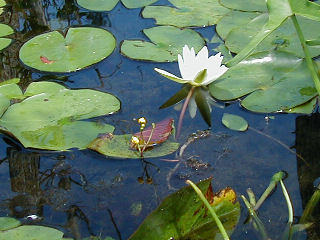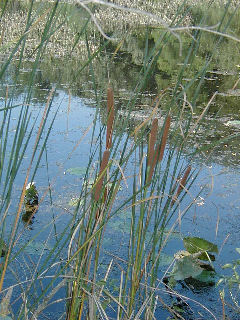The Division of Fish and Wildlife gets many questions about about aquatic plant problems in small ponds.

Aquatic plants provide habitat for fish and small pond creatures. According to biologists, plant cover between 20 and 40 percent is ideal for warmwater gamefish such as largemouth bass, bluegill, and channel catfish. These are the species recommended for small ponds by the Division of Fish and Wildlife.
However, there are some situations where aquatic weeds are a problem and may be difficult to control. Using best management practices to limit the flow of nutrients into a pond is the best way to prevent aquatic weed problems in the first place.
There are two groups of aquatic plants: algae (pond scum or moss to many people) and rooted plants.
Algae can be either planktonic or filamentous.
Planktonic algae, too small to be seen with the naked eye, often give a green or reddish cast to the water. When there is a “bloom,” a population explosion of this type of algae, it makes a thick green film on the water surface. If touched, it appears to break up.
Filamentous algae form long threads and often float in mats on the surface. The filaments can be picked up and, although limp, will remain thread-like.
Algae can sometimes be prevented by an early spring application of barley straw or controlled (temporarily) using algaecides.

Rooted aquatics are those plants with roots and are differentiated by their habitat.
Emergents, such as cattails, are rooted in the sediments but have leaves and flowers sticking out of the water. They frequently grow along the shoreline or in shallow water.
Floating plants can be free-floating or rooted in the pond bottom but the leaves grow up to the water’s surface and float there. White water lily and duckweed are typical native floating plants.
Some of the exotics (not native to Delaware), such as water hyacinth and water lettuce, also belong to this group.
Submergent plants are those where most of the plant remains underwater, such as coontail and bladderwort. Hydrilla and fanwort are two exotic species which fall into this category.

Once you have identified the type of plant, you can decide how to control it. Aquatic herbicides are one of the tools available for the control of aquatic plants.
It is important to note that the plants are symptomatic of high nutrient levels (nitrates and phosphates) within the pond. Herbicides generally kill the majority of the targeted plants present, but the nutrients go back into the water column as the plants decompose. They then become available to surviving plants to produce more growth or allow another plant species or algae to take over.
Other tools that may be used to control plant abundance are mechanical removal or triploid grass carp.
For some species such as duckweed or watermeal, pool skimmers may be very effective in removing plant material when it is blown over to one side of a small pond.
Triploid grass carp are useful to control many rooted, submersed (plants that remain under the water surface) plants, but may take 18 months or more for results. They require a permit for possession subject to established guidelines (grass carp briefing report and grass carp policy). For more information, contact the Fisheries Section at 302-735-8658.
It is critical to read the entire label of any herbicide used to determine appropriate application rates, restrictions, and precautions. Not all herbicides control all species, therefore it is important to use only those recommended by our biologists or that specifically list the plant pest that you have.
If you have any questions, contact the manufacturer.
If plants cover more than half of the pond surface, two half-pond treatments separated by a period of two weeks should be made to prevent a fish kill due to a lack of oxygen when vegetative material decomposes. An exception is fluridone which is slow-acting enough that the entire area may be treated at one time.
The Division has a list of businesses that provide pond maintenance and/or conduct herbicide applications; please call for a copy.
Some common restrictions include those for: irrigation of crops, turf, or lawns, drinking water or swimming, livestock watering, or fishing (see label for full explanation and period of restriction).
Related Topics: aquatic, dfw, fish, fish and wildlife, fishing, herbicides, outdoors, outdoors and recreation, plant problems, recreation